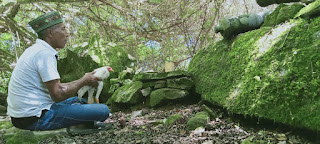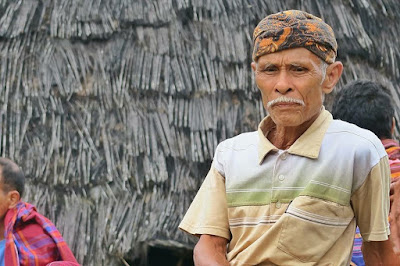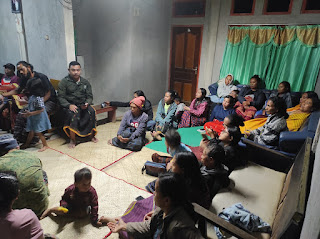Journey to Poco Leok
The maniac’s machete gleamed in the moonlight as
he ran slashing madly from house to house through the village, his terrifying
screams resounding through the lanes. Panicked villagers fled wildly as his
manic screams never stopped, until finally the cool hand of my roommate slowly
shook me out of my nightmare as he passed by my bed.
I was woken earlier than usual from my deep sleep, a very satisfying one which was unusual while I was away from home, but fractured by a combination of dreams connected to facts. The screams in my dreams actually came from neighbours drinking “sopi” (a local alcoholic drink) from their “Penti” thanksgiving ceremony. I also slowly realized I wasn’t at home, but in the house of Pastor Ino Sutam.
I needed a warm drink when I woke up. I made sure I had my sarong with me as I threaded my way quietly through those still sleeping on the floor nearby, as the morning was cold in this mountain village of Tere, our last stop before trekking to Golo Mompong. I was with a group of friends and Tour Guide Association of Manggarai exploring the area with hopes of adding it to the other fascinations of the beautiful island of Flores.
It turned out that the door was not closed, I thought there must be someone who woke up earlier than me. I started checking, my companions were still snoring, I looked around but there was no one missing. I calmed down and sat on a chair. My nightmares still resonating in my mind, I was afraid that someone has visited the house without anyone knowing. Right after I thought this, I was relieved when I saw Pastor Ino appeared through the door. He has awaked around 5 am, 30 minutes before me. Phew.
He
showed me where to get my coffee, where the toilet was, and directed me to the
viewpoint to see the surrounding landscape.
I
took out my phone and walked to the viewpoint with a cup of coffee in my hand.
Just a minute later, I could now overlook the village that I could not see the
day before because my friends and I arrived after dark.
The
day before we arrived in Tere, the weather in our home town of Ruteng was quite
bad, heavy hail, lightning and strong winds. Many trees fell. I was worried
that it would happen in Tere and its surroundings, wrecking our plans, because
it is very mountainous but until the end of the day, luckily it didn't rain.
Tere
is a small village located on a hill, with a population of some 300 people in
the Poco Leok area south of Ruteng. At an altitude of 800 m above sea level,
most people depend on farming and raising livestock. To get there from Ruteng,
it will take about an hour, driving past the mountain of Golo Lusang, well
known as the home of many of the endemic birds in Flores. The road has been
paved most of the way but for the last 30 minutes before you arrive, the road
is so very narrow and steep that you need to drive slowly.
 |
| Tere Village |
While
enjoying the coffee from viewpoint, I saw several people walking with machetes
on their belts to get to the fields where their cows were tied to be moved to a
more grassy area. I heard some people singing from several houses where they
arranged their thanksgiving, smoke appeared through the bamboo roofed kitchen,
light slowly emerged through the ridge hills, I was preparing with my phone to
capture the moment.
My
friend Filan has awaked, he came with his sarong too. His eyes looked so
reddish, he didn't want to miss the morning feeling in the village that he too
was visiting for the first time. He took some pictures and pointed out to me
mountain where we would hike after receiving information from Pastor Ino.
The
mountain looked so pretty, there are still so many trees growing, I just
couldn’t wait to hike. I finally understood why we didn’t have to leave early
in the morning because the track is so surrounded by trees that you would never
get heated by the sun.
Pastor
Ino called us to come, he and his family had prepared breakfast. My travel
mates Ino and Leo had awakened. With tumblers on their hands, they enjoyed
their drinks while seated with Pastor Ino. They have waited us for breakfast.
The table was full with dishes. Our breakfast was rice, cassava leaves mixed
with pork, carrot with broccoli, pork with soy sauce, black coffee, and banana
for the dessert. “What a delicious breakfast!” my friend Ino expressed. Pastor
Ino joked that we were lucky enough to visit the village when there was still
“Penti” the thanksgiving ceremony, with lots of sacrifice. However, we had
reason to eat heartily because we would have big task ahead.
While
having breakfast, Pastor Ino explained the highlights of the tour we would do.
He said that it would take 5 minutes with the car to the starting point and
from there, there will be another one and a half hours to trek to the point
that he called as a heritage old village belonging to Poco Leok. He added that
he used to walk on the path on foot to reach his school building when he was a
kid. Besides school, the track is used to connect the village to Ulumbu
Geothermal which is only about 30 minutes from Tere.
Right after we finished breakfast, another guiding team, Tanti and Ime arrived. They looked so ready to go. Leo, who was our coordinator, began to give us some brief instructions before leaving. He reminded us to count the time we would spend by using a timer, and reminded us why should have trekking shoes on. “If you trek in the hot temperature area, you must wear shoes not sandals because even if the track is easy and it is uncomfortable for the feet, there are lot of poisonous animals like snakes, scorpions, and centipedes that can bite you. When you trek in the higher elevated areas, you don’t have to worry about those poisoned animals, but you just need to be careful with some thorny plants that can hurt you anytime”.
Pastor
Ino turned to lead us in a prayer. He thanked God for the health, for the
beautiful earth, sky, mountain, water, and air that God has created. As we
would experience the God’s creatures, he hoped God protect the activities we
would do, especially to be blessed for the trekking to Golo Mompong.
The
prayer was over. When we were all ready, Pastor Ino asked us for some help to
carry a box of rice, water, and a chicken for sacrifice.
The
guiding team consisting of 6 members, all of us here to look for tourism
potential in Poco Leok, sat in the car accompanied by Bapa David and Pastor Ino
as local tour guide and community figure. After only 5 minutes drive, we were
at the starting point of our journey. The road conditions were very hilly but
in good condition.
Some
passers-by approached us, wondering what we wanted to do and Pastor Ino
explained “They are people from Ruteng who work in tourism as tour operators
and tour guides. They come to survey the potentials of tourism in Poco Leok in
hope that in the future there will be tourists who extend their length of stay
during their visit in Flores”. They looked so enthusiastic and supportive in
response, saying “take care”.
Just minutes from the starting point, we were greeted by a viewpoint. Pastor Ino began to point out villages and shared a little story about the meaning of Poco Leok. "Poco means mountain and “Leok means surrounding", so Poco Leok means surrounded by mountains. He also said that if there are about 14 villages and each of them has their own ”Mbaru Gendang” or main traditional house and all of the area is referred to "Poco Leok" and those villages surrounded by mountains.
Pastor
Ino explained very enthusiastically anything we saw along the way, adding the
story of his and his people’s way of life in Poco Leok. He often had to explain
in Manggarai language the plants that we even did not understand, only Leo who
understood so well due to his special interest in plants and animals. No wonder
during the walk, they spent most of the time together and left us behind with
Ino as the video maker, Filan with a sigren of water on his hand, Ibe who suffered
a lot from leeches that sucked her blood, Tanti who cried to Ino to be shot on
his phone, and I who carried my box of rice.
After 30 minutes walk, we saw two kids carrying firewood and a guy with a bottle of arak. This guy who I saw in the morning with the machete on his belt was coming back home to bring “Tuak Bakok” or white fermented arak. He had to stop when looking at Pastor Ino. He greeted us in a very friendly way, just like most Flores people do, but this time I felt special as he offered us his “Tuak Bakok” to taste. When pastor Ino asked him if we could have it, he gave it all without hesitation but not before he drank one full glass.
For
people in Poco Leok, “Tuak Bakok” is a welcome drink for guests who visit their
village. As we experienced a day we arrived, the house owner welcomed us with a
boiled banana, boiled cassava roots, and ”Tuak
Bakok” as a drink. ”Tuak Bakok” is made from sap from a palm tree that
commonly grows in the forest of Poco Leok. It can just be fermented naturally
without adding anything to be drinkable but if you want to make it stronger
like “sopi”, it is distilled. According to Pastor Ino, “Tuak Bakok” in Poco
Leok is different from other places. If in another place you only could produce
10-15 liters of “Tuak Bakok”, you will have 25-30 liters of “Tuak Bakok” from
Poco Leok”, he claimed. “It is because of the elevation, the higher the more.”
After
an hour of walking, we arrived at the track which is a cliff on both sides, we
can see from the viewpoint of the village in the valley in the east, it looks
very beautiful coupled with plantations and coconut growing surprisingly there.
Leo called us to approach him immediately because he felt a strange
temperature. After experiencing cold and humid temperatures in the middle of
the rainforest we experienced warm temperatures. Bapa David who was still
holding the chicken for sacrifice explained; "There are hot springs down
there, here we have found some hot springs, but the Ulumbu hot springs in the
West are the hottest that no one can swim". "No wonder we smelled
sulfur while walking, there must be hot springs near the area," Ino
responded.
Bapa
David told us we were about to arrive. I decided to walk closer to Pastor Ino
as I still had my phone recording in order not to miss any information.
Bapa
David began to worship. He mentioned all the spirits who guard the mountain in
order to welcome us without anyone getting hurt. He also explained to the spirits that we were
people working in tourism, come to see the area in order that in the future we
will bring good things to the people of Poco Leok. He hoped that by this
offering, we were all permitted to enter the old village.
After
the ritual, Pastor Ino who apart from his village duties, also works as the
chief of the culture and tourism commission of Ruteng’s Bishopric, explained
why we had to do the ritual. He said that the ritual is called as a permission
ritual which is aimed to pay respect to all the creatures especially “empo ata pang be le” or the people who
have passed away. He also said that by doing so, the spirits will recognize who
the people are without asking who you are that cause to sickness. As he further
explained that In Manggarai if the spirits pointing at you to ask about who you
are, it will be a bad gesture that cause to someone’s sickness.
As we walked slowly to the old village, the
situation became completely different. The land was flat, the plantations were
different from we had seen. Rocks seen stuck on the ground, Pastor Ino
explained, they were gravestones. About 20 meters away, we could see a pile of
rocks known as “Compang”, an altar where people used to deliver their
offerings, and bizarrely two ancient iron cannons.
We
had all arrived safely after a challenging journey. There was few points where
we’d had to be very careful because the track was not often used. We had to
contort when walking under tree roots, passing through a small pond where wild
boar might be swimming, navigate between
some thorny plants, and some steep inclines that stretched your energy. But all
paid off when arrived at the peak, spiced with the fact that Bapa David looked
ready to sacrifice the chicken. Some new meat was underway.
It seemed hard to believe that people lived in such a pure jungle some years ago. It was even more mystical once we reached the altar. There was the grave of a “Dalu” or a king of Poco Leok named Antonius Laro Janggor who died in 1946, a year after Indonesia was independent.
Pastor
Ino said he visited the old village every year for prayers and offerings to the
spirits as the king was his relative. This time, due to Penti thanksgiving
ceremony, Pastor Ino and Bapa David brought with them chicken and rice so that
they could do the “teing hang” ritual
or to a ritual to feed the spirits who belonged to their relatives.
My
companion Filan asked if we had to do the same when we come with tourists. “No,
It is only required for a special purpose. However, when coming with tourists,
you will need to do the permission ritual in order to be safe and comfortable”,
Pastor Ino answered.
Pastor
Ino dressed up, he had prepared his traditional outfit, a red sarong commonly
called as ”towe Todo”, a white shirt,
and traditional hat on his head. Bapa David sat near the head of the grave with
the chicken on his head, as he began to worship to invite all the spirits to
get involved in the ritual as part of “Penti”
thanksgiving ceremony.
The
chicken was sacrificed, arak poured as a beverage, and a cigarette put on the
altar made of pile of rock that looked very old with some moss growing on their
surfaces. We all ate the remaining of
the sacrificed chicken after the ritual was completely done.
 |
| Bapa David sacrificed chicken for the spirits. |
When
he passed away he was replaced by Kode Rae who was very popular in his prime
time. He left the village and passed away in Wae Mokel village, the border of
Manggarai regency and Bajawa regency.
In 1931, Antonius Lako Janggor rebuilt the
village, and he was noted as the last “Dalu”
who lived in Golo Mompong”. Golo Mompong was the first village that pioneered
to 6 main villages belonged to Poco Leok.
Pastor
Ino said Golo Mompong was left by the inhabitants when there was war in Kode
Rae’s era.
Pastor
Ino also explained about where the cannons were originally from. He said that
the cannons were brought from Golo Rampas Lawa, on the South part of the old
village, Golo Mompong. “It is a rough information about the quantity of the
cannons, some said there were four and five, but there left only two cannons
because Dutch colony have taken it away”.
An
old villager of Poco Leok whose name not to be mentioned claimed that the iron
cannons were brought by Dutch Colony as their support to Poco Leok when there
was a war between kingdoms in Manggarai.
Leornardus
Nyoman explained that for birds living around
Coffee garden and yard, there lived Chestnut-backed Thrush, Black-naped
Monarch, Wallacean Drongo, Helmeted Friarbird, Tenggara Paradise Flycacther,
Elegant Pitta, Green Junglefowl, Moluccan Scops-owl. And those living in and
around rainforest, there lived Bare-throated
Whistler, Flores Scops-owl, White-rumped Kingfisher, Flores Hawk-eagle,
Black-backed Fruitdove. And another endemic animal is Flores Giant Rat (Papagomys armandvillei).
Ino
Jemadu, a tour guide and journalist, shared his thoughts about the experience
to trek to Golo Mompong. He said that the place is very recommendable for those
who like trekking. The track was not that hard but also not that easy. Anyone
with reasonable fitness could make it. Besides enjoying the natural beauty, the
travelers will also learn about the history of the villagers who lived here in
the past.
 |
| left to right: Ino, Filan, Tanti, Bapa David, Irwan, Ibe, Pastor Ino, and Leo. |
Tanti,
who has sixth sense, now spoke out about what we couldn’t see but she claimed
she did. She saw a very old lady with a stick, struggling to move her legs,
whispering in her ear to ask to be mentioned and prayed for, saw many children
were still playing, and an old man who was seated next to Filan. When she said
this, Filan was very shocked and jumped up to stand near Pastor Ino. He looked
so afraid but eventually relaxed when Tanti said she was joking.
Tanti said if the spirits would not hurt anyone as long as we did not take anything out from that village.
She
also said “the spirits are still alive in different world apart from us, as
human beings we need to pray for them so that they will rest in peace”.









Komentar